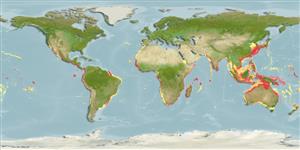Issue
This species is considered as a junior synonym of Mobula mobular according to Last et al., 2016 (Ref. 114953) and White et al., 2017 (Ref. 115945:13). The species page will be removed,.
Environment: milieu / climate zone / depth range / distribution range
البيئة
بحري مرتبطة بالشعاب; نطاق العمق 0 - 647 m (Ref. 106604), usually 0 - 200 m (Ref. 89423). Subtropical; 40°N - 30°S
Indo-Pacific: off South Africa, the Arabian Sea eastward to the Hawaiian Islands and Polynesia. Eastern Pacific: on the continental coast. Eastern Atlantic: Côte d'Ivoire but may probably be more wide-ranging. This has to be critically compared with Mobula mobular of the Mediterranean Sea and nominally elsewhere in the North Atlantic.
Length at first maturity / الحجم / وزن / العمر
Maturity: Lm 217.8, range 204 - ? cm
Max length : 310 cm WD ذكر/ مختلط الجنس; (Ref. 50641); 240.0 cm WD (female); common length : 225 cm WD ذكر/ مختلط الجنس; (Ref. 9256)
Dark blue to black above, white below. Inner surface of cephalic fins silver grey with black tip, outer surface and side behind eye white (Ref. 11228). Shared characters between M. rancureli and Mobula japanica: teeth, placoid scales, and branchial filter morphologies, morphometrics, presence of tail spine, distinctive shape and coloration of dorsal fin, and general shape of body and coloration (Ref. 50641).
Found inshore, possibly in oceanic waters (Ref. 9911). Pelagic (Ref. 58302). Occurs singly or in groups (Ref. 9911). Feeds mainly on euphausiids (mainly Nictiphanes simplex), and to a lesser extent on copepods and crustacean larvae. May also feed on small fishes. Ovoviviparous (Ref. 50449). Acoustic tracks record the species to spend time above the thermocline at night to feed on krill (H. Dewar, pers.comm. 05/2000). Very common by-catch of the gillnet fisheries targeting skpjack tuna (Katsuwonus pelamis). Utilized for its gill filter plates (very high value), meat, cartilage and skin (Ref.58048).
Exhibit ovoviparity (aplacental viviparity), with embryos feeding initially on yolk, then receiving additional nourishment from the mother by indirect absorption of uterine fluid enriched with mucus, fat or protein through specialised structures (Ref. 50449). With one in a litter (Ref. 12951). Size at birth 85-92 cm WD (Ref. 12951, Ref.58048).
Last, P.R. and J.D. Stevens, 1994. Sharks and rays of Australia. CSIRO, Australia. 513 p. (Ref. 6871)
IUCN Red List Status (Ref. 130435)
استخدامات بشرية
مصائد: تجاري
أدوات
تقارير خاصة
Download XML
مصادر علي الأنترنت
Estimates based on models
Preferred temperature (Ref.
123201): 17.5 - 29, mean 27.4 °C (based on 5840 cells).
Phylogenetic diversity index (Ref.
82804): PD
50 = 0.5005 [Uniqueness, from 0.5 = low to 2.0 = high].
Bayesian length-weight: a=0.01000 (0.00244 - 0.04107), b=3.04 (2.81 - 3.27), in cm total length, based on all LWR estimates for this body shape (Ref.
93245).
مستوى غذائي (Ref.
69278): 3.4 ±0.43 se; based on food items.
Generation time: 9.2 ( na - na) years. Estimated as median ln(3)/K based on 2
growth studies.
المرونه (Ref.
120179): منخفظ جدا, الحد الزمني الأدني لتضاعف عدد أفراد المجتمع أكثر من 14 سنة (Fec=1).
Fishing Vulnerability (Ref.
59153): High vulnerability (58 of 100).
Nutrients (Ref.
124155): Calcium = 2.5 [0.3, 39.7] mg/100g; Iron = 0.39 [0.03, 4.65] mg/100g; Protein = 21.4 [16.2, 26.7] %; Omega3 = 0.111 [0.035, 0.336] g/100g; Selenium = 28.3 [5.3, 165.3] μg/100g; VitaminA = 9.7 [0.8, 119.6] μg/100g; Zinc = 0.322 [0.021, 3.683] mg/100g (wet weight);
